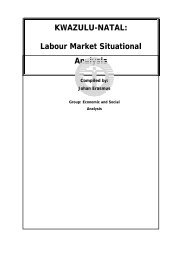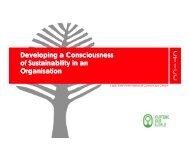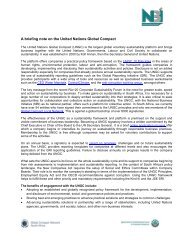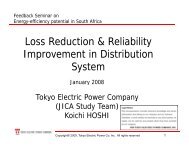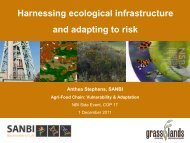Sustainable Forest Finance Toolkit - PwC
Sustainable Forest Finance Toolkit - PwC
Sustainable Forest Finance Toolkit - PwC
- No tags were found...
You also want an ePaper? Increase the reach of your titles
YUMPU automatically turns print PDFs into web optimized ePapers that Google loves.
<strong>Forest</strong> carbon and otherecosystem services briefing note2 of 5New Application HOMEUptake and emissions from land-use change between 1850 and 2000 *Keeping up-to-date with <strong>Forest</strong> CarbonThe negative emissions,(uptake) post-1940 are largelydue to increasing forest area inthe US and Europe. The peakemissions in 1990 are linked toforest fires in IndonesiaSource: Stern, 2007* Note: This graph depictsemissions based on land usechange. Other calculationsconclude that the terrestrialecosystem is a net carbon sink.<strong>Forest</strong> Carbon is a fast-moving topic and changes month by month. These useful sources help provide updates on thecurrent issues:• The <strong>Forest</strong>s Dialogue: http://research.yale.edu/gisf/tfd/• UN-REDD: http://www.un-redd.org/• <strong>Forest</strong> Carbon Portal: http://www.forestcarbonportal.com/Page 56<strong>Sustainable</strong> <strong>Forest</strong> Management (SFM)Sustainably managed forests are approximately carbonneutral. They form a mosaic across the landscape in whichthe growth of trees over a given area will compensate for thecarbon lost through annual logging of a much smaller area.On the other hand, a forest landscape subjected to land-usechange or over-harvesting will release more carbon than ittakes up. The rate of recapture of atmospheric carbondepends on several factors:A young stand with small trees will absorb carbon as thetrees grow, but the amount of carbon stored is initially small.The rate of storage is proportionate to the high rate of growth,and managed forests sequester a pool of carbon, withharvest balanced by re-growth.An old stand with big trees is the result of a long period ofbiomass accumulation. Although the science is stillinconclusive, it is generally accepted that old stands with bigtrees store large amounts of carbon. As their growthstagnates they may no longer take up as much carbon asthey release.Stable old-growth forests are a valuable pool of storedcarbon. Replacing these stands with young, vigorouslygrowing trees would reduce the amount of carbon stored onthe land, and it would take decades, or even centuries, forthe newer stands to recapture it.Sustainably managed forests, however, play an importantrole in climate change mitigation. Harvested wood productsand wood-based bioenergy from forests already beingsustainably managed contribute to climate mitigation throughcarbon sequestration and avoided emissions whensubstituted for more energy intensive materials. The IPCCfourth assessment report wrote 'In the long term, asustainable forest management strategy aimed atmaintaining or increasing forest carbon stocks, whileproducing an annual sustained yield of timber, fibre, orenergy from the forest, will generate the largest sustainedmitigation benefit.’pwc



